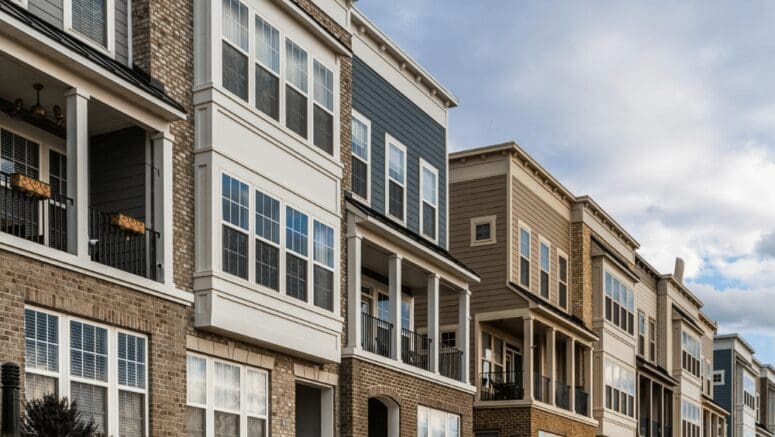What Exactly Is a Multifamily Home and Is It the Right Investment for Me?
- Published on
- 10 min read
-
 Lily Allen-Duenas, Contributing AuthorClose
Lily Allen-Duenas, Contributing AuthorClose Lily Allen-Duenas Contributing Author
Lily Allen-Duenas Contributing AuthorLily Allen-Duenas is a writer, content storyteller, and graphic designer with over 7 years of professional experience. Her work spans sectors including real estate, travel, health, wellness, arts, and culture. Through all her endeavors, she seeks to build pathways for conversation and connection.
-
 Jedda Fernandez, Associate EditorClose
Jedda Fernandez, Associate EditorClose Jedda Fernandez Associate Editor
Jedda Fernandez Associate EditorJedda Fernandez is an associate editor for HomeLight's Resource Centers with more than five years of editorial experience in the real estate industry.
When you hear the term “multifamily home,” what comes to mind? For those who aren’t particularly real-estate savvy, you may picture images of the in-laws moving in, or perhaps even the aunts, uncles, and cousins to boot! What about the friends who come to visit for a week and end up staying … indefinitely? Cringe.
Luckily, that isn’t necessarily what a multifamily home is. A multifamily home is a residential property that has one or more housing units — and you’ll find it in many forms.
Multifamily homes can also be a great way to begin your foray as a real estate investor. They can serve as a wealth-building tool and as a way to generate passive income. While there are many potential financial benefits, it’s important to know not just the basics, but also the pros and cons, and the best strategies for purchasing a multifamily home.
Sit back and relax. Make a cup of tea or grab yourself a cold one. We’re about to do all the heavy lifting for you and give you the 411 on all there is to know about multifamily homes. Ready? Let’s get to it.
What is a multifamily home?
A multifamily home is housing involving or common to more than one family. More specifically, The Law Dictionary defines a multifamily home as a structure built “to house several different families in separate housing units. The entire building or structure may be owned by one person, a company, or by individuals who have purchased units, as is the case with condominiums. An apartment building is the most common multifamily housing type.” Leave it to the lawyers to be exceptionally thorough. Moreover, with multifamily homes, each dwelling unit typically has its own address, kitchen, bathroom, entrance, and utility meter.
In other words, a multifamily home is a residential property that houses separate residences where more than one family can live completely independently of each other. It isn’t a home that simply has enough basement space for your college grad. In fact, residential multifamily homes have four units or less. Technically speaking, if the building has more than four units, then it qualifies as a commercial property. Of course, commercial real estate differs from residential real estate and we’ll only be covering residential real estate in this article.
Lastly, it is worth pointing out that in multifamily homes, the owner often opts to live in one of the units. If this is the case, it is considered an owner-occupied property. However, it’s not a requirement for the owner to occupy a unit. That said, there are certainly cost-saving benefits to occupying a unit yourself (more on this later).
Types of multifamily units
How about a lightning-fast overview of the different types of multifamily units? We’ll just go ahead and take that as a yes.
Duplex
A duplex is a house that is divided into two separate homes or two units in one singular building — regardless of how the units are arranged. Units may be stacked on top of each other with one unit per floor or side by side.
Triplex
A triplex is also known as a three flat. This is when there are three units existing side by side or in a three-story configuration.
Quadplex
A quadplex is also called a fourplex and — as you might have guessed — is a multifamily housing unit that is divided into four units existing side by side, or as two first-floor units and two second-floor units. While from the outside a quadplex may appear to be just one big house, the interior is clearly divided into four separate dwelling units.
Townhouse
A townhouse is defined quite simply as a house that is joined to another house. Usually, a townhouse is one in a row of similar houses that are joined by a shared wall, but all have separate entrances. These attached side-by-side houses may also be called townhomes or row houses.
Often confused with a condo, as both are usually part of complexes, there is one key difference between a condo and a townhouse. With a condo, an owner only owns the inside of the residence itself — not the land or the building’s exterior. In a townhouse, the owner will usually own the inside, outside, and the plot of land it sits on.
Condominium
A condominium is a privately owned individual unit within a community of other units. Condo owners share common areas, such as pools, gyms, and garages, but they are only responsible for the upkeep and maintenance of their own interior dwelling space. That means that there is no lawn to cut, no flowerbeds to maintain, or driveways to be cleared of snow.
Apartment complex
An apartment complex is a building or a group of buildings on one lot under single ownership, with at least one building, and containing three or more dwelling units. Remember that for an apartment building to qualify as a residential property it must have four or fewer units. If it has more than four units it is deemed as commercial real estate.
Semi-detached house
A semi-detached house is a single-family home that simply shares a common wall with another home. These are quite similar to townhomes, yet are often the result of building additions to pre-existing homes.
So who buys multifamily homes?
There’s no one-size-fits-all real estate investment, but multifamily homes may be as close as you’ll get. Multifamily homes can make for an excellent start to building an investment portfolio for novice real estate investors, as well as for experienced investors who want to reap the financial benefits that come from renting multiple units in one fell swoop — with a single purchase!
Owning a multifamily home can be a “house hack,” as you can buy a home, live in one unit, and rent out the other units. This can also be a great option for multigenerational families who want to live close to one another yet still require their own space and privacy.
If you’re purchasing a multifamily home to expand your real estate portfolio, what do you need to know? Matt Walls, Edward Jones’ financial adviser, says first and foremost, it’s essential that you’re clear about what your goal is for the property.
“Typically it will be one of two things, cash flow or appreciation, which could be achieved by renovations or simply by getting a great deal on the purchase,” he says. “If going the cash flow route, you would need to know your [capitalization] rate. A good cap rate is 5% or higher. A cap rate simply means the net income of the property divided by its market value.”
Walls also notes that it’s important to have an exit strategy in mind. Yes, you read that correctly. Before you make your investment, you should think about how you’ll be able to move on from it (when you eventually move on) to get the best return on your investment.

Investing in multifamily homes vs. single-family homes
If you’re debating whether to invest in a multifamily home or a single-family home, there are a lot of variables to consider. Why would you buy one instead of the other? Just as you might have a pro-con list running through your head, or maybe on a sticky note on your desk, we thought we’d do some of the legwork and walk you through the pros and cons of a multifamily home versus a single family home to help you determine which investment is the right one for you.
The pros of buying a multifamily home
- Can provide a consistent cash flow from rental income
- Lower vacancy risk — it is unlikely that all units will be vacant at once
- Flexible financing options — you may still qualify for a conventional, FHA, or VA loan for a small multifamily home
- Potential tax benefits for the owner — can write off most of the repairs and the interest you pay on your mortgage as a business expense
- Easier to increase value — improvements can lead to rent increase
- Great start for growing your property portfolio
Top HomeLight real estate agent David Stafford, of Albuquerque, New Mexico, has 20 years of experience helping buyers find the right homes. Stafford also owns 25 properties himself. Nearly half of his real estate portfolio is multifamily homes, and he manages 40 tenants. Stafford notes that a benefit of investing in a multifamily home as a rental property is that you may see a higher return on your investment faster than you might if you purchase a single-family home to rent because there are more units. For example, if you purchase a fourplex, you’ll have three to four units (depending on if you’ll be an owner-occupant) as potential income streams rather than a single stream with a single-family home.
Additionally, if a new investor purchases a triplex or a fourplex, it’s convenient from a property management perspective. Rather than driving all over town to manage multiple properties and attend to your tenants’ requests, there is only one location to visit. This saves time and allows you to be a more efficient landlord.
The cons of buying a multifamily home
- Properties aren’t always easy to find
- Often more expensive than single-family homes
- Added costs of being a landlord, including maintenance, repairs, vacancies, and time commitment
- Tenant management may be tough, and you may need to hire a property manager
- Potentially higher operating expenses because of tenant turnover
- Limited exit strategies
- Both property taxes and insurance rates are higher than single-family homes
“More tenants means more management,” Walls says. “Whether it falls to you or to a property manager, it’s going to take time and energy to source good tenants and keep up with the repair requests.”
Pros of buying a single-family home to rent out
- Variety of options to choose from in any market
- Longer tenant leases
- High resale value if well-maintained and in a thriving neighborhood
- Reduced operating expenses mean lower cost to manage
- Insurance for single-family homes is cheaper than for multifamily homes
- Multiple exit strategy options: owner-occupant, another investor, or the tenant
Stafford finds that longer-term tenants are generally more invested in the property itself.
They tend to have a little bit more financial capability to take care of the property and stay longer, so that means I have less hassle.
 David Stafford Real Estate AgentClose
David Stafford Real Estate AgentClose David Stafford Real Estate Agent at 360 Ventures Real Estate Currently accepting new clients
David Stafford Real Estate Agent at 360 Ventures Real Estate Currently accepting new clients
- Years of Experience 21
- Transactions 1356
- Average Price Point $308k
- Single Family Homes 1183
Cons of buying a single-family home to rent out
- Limited opportunity to add value and earn rental income
- Vacancies reduce your return on investment
- You are usually responsible for exterior maintenance
- Harder to scale up your real estate portfolio if you’re buying one house at a time
The cons of buying a single-family home include being tenant dependent and being locked into a more limited income stream. When renting out a single-family home, if the property is vacant, your single source of income dries up — fast! As tenants come in with longer leases, there is less opportunity to increase rent and to increase your income stream.
Tax and financing benefits of multifamily homes
Just as first-time homebuyers may enjoy tax benefits, there are tax and financing advantages for owner-occupant properties as well. Stafford points out that you can finance owner-occupant multifamily homes with up to four units through an owner-occupant loan, opening the door for government-backed loan options that may have lower rates and lower down payments than a conventional loan.
There are also federal and often even state tax deductions available for owner-occupant housing. For example, if you’re buying property in Ohio, you’re eligible for a 2.5% deduction on your property taxes. Take time to research federal and state guidelines programs so you don’t miss a savings opportunity.
How to find a multifamily home
This all sounds great, but now you’re probably wondering about how to find a multifamily home. While there are a few different ways to go about your search, the best way is to let an expert guide you. Work with a top buyer’s agent who will help you find a property that aligns with your specific needs.
It’s also a good idea to conduct a quick online search to get a feel for what is out there and how the market is looking. Keep an eye out for neighborhoods that seem to be in high demand, and where homes retain their value better. Your agent can point you to useful housing market data to help narrow your search.
You also could attend foreclosure auctions to try to snag a deal, though note that you’ll have to pay in cash, and there’s more risk involved with these properties. Before attending an auction do your research, consult a top agent who specializes in distressed properties, and, if at all possible, do a drive-by of the properties up for auction.
What to look for in a multifamily home
On the hunt for a multifamily home? Let’s make sure you have all the information you need in your back pocket to make a decision that is right for you and sets you up for success!
Location
When looking for a multifamily home, there are quite a few things you want to make sure to consider. First, it may come as no surprise, but — location, location, location. A desirable location makes it that much easier to attract tenants and to have a property that retains its value well over time. That means faster turnover, less money lost on vacancies, and a higher resale value when you are eventually ready to sell the property.
Strong market
You’ll also want to understand the strength of the market in the area. With solid job growth and a diverse employment base, there’s usually the potential for more tenants on the lookout for rentals! Keep an eye out for new construction, and notice if there are a large number of apartments, complexes, or rental properties in the area and see how they are faring. Lastly, consult the US census to determine the percentage of renter-occupied households and market vacancy rates.
Potential rental income
When doing your research, take note of monthly rental rates for multifamily properties and how that changes based on location, square footage, or amenities. See if you can find a rental property that is similar to what you are considering buying and then do some simple calculations to figure out your potential annual rental income.
Number of units
The number of units is definitely an important factor to consider when making your decision on which multifamily home is right for you. While more units means more rental income, it also means more tenants to manage and units to maintain.
The seller
Is this a no-brainer? Or is the secret key to success? Knowing an owner’s motivation for selling a property can provide you valuable insight to how the property is performing and understanding if there is a good reason a seller is offloading a particular multifamily home. Did the seller maintain the property well? Make sure to tour the property and to be on the lookout for glaring red flags like strong odors and the condition of the walls and the floor.
So are you ready to accelerate your wealth-building and start a portfolio that could pay dividends over the long run? If you are in the market to buy a multifamily home, connect with a top buyer’s agent who can guide you in your search, and provide invaluable insight to help you make the best investment possible.
Header Image Source: (Derrick Brooks / Unsplash)
- "The 6 Types of Commercial Real Estate Property," View The Space (May 2023)
- "Owner-Occupied Definition," Retipster
- "What Is a Duplex?," The Spruce (May 2024)
- "What Is a Townhouse?," Architectural Digest (November 2023)
- "What Is A Condo? A Complete Breakdown of Condos," Hudson Condos (February 2024)
- "Semi-Detached House: Everything To Know Before Buying," Quicken Loans (November 2023)
- "What Is House Hacking In Real Estate?," Quicken Loans (January 2024)
- "Capitalization Rate: Cap Rate Defined With Formula and Examples," Investopedia (August 2024)
- "The Tax Implications of House Hacking," BiggerPockets (January 2024)




